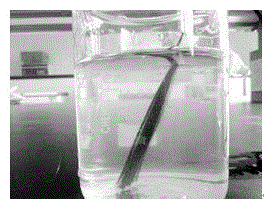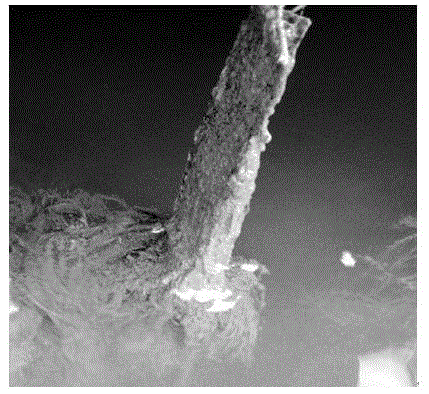Method of surface modification for environmentally-friendly carbon fibers
A carbon fiber filament and surface modification technology, applied in chemical instruments and methods, water/sludge/sewage treatment, biological water/sewage treatment, etc., can solve the problems of easy clogging of natural fillers, insufficient strength and toughness, chemical reactions, etc. problems, to achieve enhanced bio-affinity, increased film-hanging rate and film-hanging rate, and good results
- Summary
- Abstract
- Description
- Claims
- Application Information
AI Technical Summary
Problems solved by technology
Method used
Image
Examples
Embodiment 1
[0035] 1) Soak the PAN-based carbon fiber precursor in acetone solution with a mass fraction of 95% for 2 hours, take it out and dry it; then soak it in nitric acid with a mass fraction of 65% for 4 hours, take it out, and dry it at a temperature of 120°C Dry to obtain preliminary modified carbon fiber filaments.
[0036] 2) Put the preliminarily modified carbon fiber filament into the tube atmosphere furnace, and pass CO 2 , to control CO 2 The flow rate was kept at 500mL / min. After the temperature was raised to 850°C, the heating was stopped, and it was naturally cooled to room temperature and taken out to obtain modified carbon fiber filaments.
[0037] 3) Comparative test
[0038] The non-modified carbon fiber filaments and the modified carbon fiber filaments were subjected to a film-hanging comparison experiment, and the film-hanging situation was observed after the comparison test was carried out for 6 days.
[0039] Such as image 3 The comparison chart of the 6-day...
Embodiment 2
[0046] 1) Soak the PAN-based carbon fiber precursor in an acetone solution with a mass fraction of 96% for 2 hours, take it out and dry it; then soak it in 65% nitric acid for 4 hours, take it out, and bake it at 100°C Dry to obtain preliminary modified carbon fiber filaments.
[0047] 2) Put the preliminarily modified carbon fiber filaments into a high-temperature and high-pressure furnace, use water vapor as the activation gas, adjust the pressure to 126Mpa and keep it for 3 hours, take it out and dry it at 150°C to obtain modified carbon fiber filaments.
[0048] 3) Film-hanging experiment: The obtained modified carbon fiber filaments were subjected to a film-hanging experiment in the natural lake water of East Lake, and the film-hanging situation was observed after 3 days;
[0049] Figure 6 Shown is the picture of the hanging film of the modified carbon fiber filaments made under natural water bodies;
[0050] Figure 7 A microscopic view of a modified carbon fiber fil...
Embodiment 3
[0054]1) Soak the PAN-based carbon fiber precursor in an acetone solution with a mass fraction of 97% for 4 hours, take it out to dry; Dry to obtain preliminary modified carbon fiber filaments.
[0055] 2) Put the preliminarily modified carbon fiber filament into the tube atmosphere furnace, and pass N 2 , control N 2 The flow rate was kept at 300mL / min. After the temperature was raised to 800°C, the heating was stopped, and it was naturally cooled to room temperature and taken out to obtain modified carbon fiber filaments.
[0056]
PUM
| Property | Measurement | Unit |
|---|---|---|
| adsorption | aaaaa | aaaaa |
| quality score | aaaaa | aaaaa |
Abstract
Description
Claims
Application Information
 Login to View More
Login to View More - R&D
- Intellectual Property
- Life Sciences
- Materials
- Tech Scout
- Unparalleled Data Quality
- Higher Quality Content
- 60% Fewer Hallucinations
Browse by: Latest US Patents, China's latest patents, Technical Efficacy Thesaurus, Application Domain, Technology Topic, Popular Technical Reports.
© 2025 PatSnap. All rights reserved.Legal|Privacy policy|Modern Slavery Act Transparency Statement|Sitemap|About US| Contact US: help@patsnap.com



